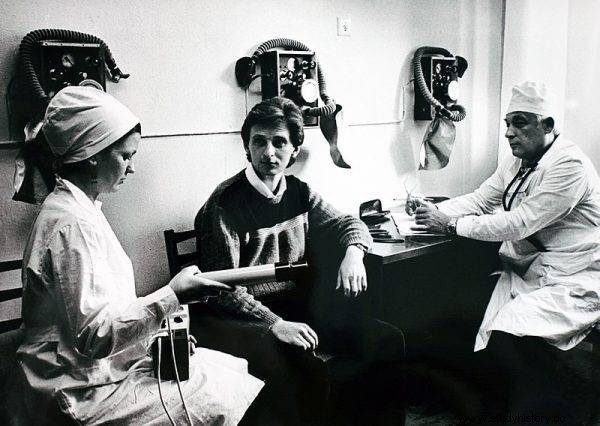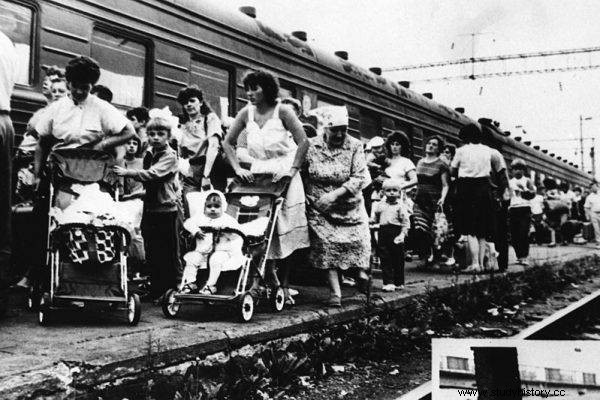As a result of the accident at the Chernobyl Nuclear Power Plant, which happened on April 26, 1986, about 5 million people suffered, including nearly 600,000. kids. Radioactive radiation contributed to the death of up to 60,000 people. people.
Years later, the then General Secretary of the CPSU Central Committee, Mikhail Gorbachev, admitted that no one - even the greatest experts in the field of nuclear energy - could have foreseen the tragic consequences of this catastrophe. The situation around the power plant has often been compared to a genie that was released from a bottle and began to wreak terrible havoc.
A fire that could not be extinguished
The explosion at the power plant, which was actually not in Chernobyl, but 4 km from the city of Pripyat, took place at 1:24 am on the night of April 25-26. The explosion destroyed Reactor IV, and an incandescent red-yellow-orange radiation pole 1 km high was fired into the air. The clouds moving over Pripyat were contaminated. Then the wind blew them away.
After just a few minutes, groups of firefighters arrived at the site of the accident. They started dousing the reactor with water but - as one of the witnesses and participants of the tragedy said later - " this strange fire could not be extinguished ". When the officers' efforts failed, several of them made their way to the roof.

The inhabitants of Pripyat were not informed about the failure and the resulting threat.
As no one had informed the firefighters of the nature of the fire and its dangers, they climbed the mountain without any security measures. Later it turned out that the level of radiation there was so high that within an hour the firefighters took a dose 50 times the dose that is safe for humans. As early as 2 am they started showing signs of radiation sickness:they were vomiting, they had nosebleeds and they fainted.
The officers were transported to the hospital in Pripyat, from where they were then transported to the Moscow hospital No. 6 - the only medical facility in the USSR treating radiation sickness. There - in terrible torments - about 50 of them died. Due to bone marrow damage, their bodies began to mummify spontaneously and the skin fell off in whole sheets .
A day like every day
The inhabitants of Pripyat were not informed about the failure and the resulting threat. In 1986, spring turned out to be exceptionally warm. The film chronicle of April 26, 1986 showed women in short-sleeved dresses pushing baby carriages and toddlers playing in the sandbox. In the morning the children went to school as always and kindergartens. The only thing that made this day different from hundreds of others were the policemen with facial masks in the streets.
Meanwhile, regular military personnel measured the level of radiation, which - to their horror - was rising sharply. In the evening of April 26, it exceeded the norm 600,000 times! Then the authorities in Moscow decided to evacuate all the inhabitants of Pripyat. It was decided to take people away by specially prepared coaches.
Residents found out about the evacuation on April 27 at 12:00 with the official announcement. They were told that they would have to leave their homes for three days and were ordered to take the documents and the most necessary things. The departure from Pripyat was to take place at 14. Over 1,000 coaches were provided, with 43,000 boarded. people. The column of vehicles stretched for several kilometers. Soon, residents were also evacuated from the 30-kilometer zone around the power plant.
According to BBC journalists, the authors of the documentary "The Battle of Chernobyl", staying in the infected city over a day after the explosion of the 4th reactor caused irreversible changes in the bone marrow and blood of the inhabitants of Pripyat, and as a result contributed to oncological diseases. Unfortunately, to date, no thorough research has been conducted on the health status of the population from infected areas and subsequent generations.

Residents found out about the evacuation on April 27 at 12:00 with the official announcement. They were told that they would have to leave their homes for 3 days
The authorities did not inform the citizens about the danger to their health and life. Pregnant women, or rather their unborn children, whose thyroid gland absorbed radioactive elements, which could result in irreversible changes in the body of the fetus, were the most at risk. Therefore a secret order was issued according to which pregnant women in the 30-kilometer zone were to be referred for abortion.
Irina Mitina, who is expecting her first child, experienced this experience. When the woman came to relatives in the Vinnytsia region at the end of April 1986, she immediately reported to the obstetrics and gynecology clinic and informed the doctor about her situation. The latter stated that the pregnancy was not going well and ordered her to drip into the operating room.
Irina wanted to protect her child at all costs, so she escaped from the clinic through the window (the building was one-story) and was hiding with friends. After a few months, she gave birth to a boy who turned out to be slightly mentally retarded. Was his condition due to his mother's stay in Pripyat in April 1986?
Disaster recovery
After the evacuation of residents in Pripyat, only the military and various specialists remained, whom the authorities brought in to remove the consequences of the disaster at the power plant. Airmen brought to the city from the war in Afghanistan, with extensive experience in piloting helicopters, came to the city. The task of the military was to fight the fire of the 4th reactor, as the fire was still smoldering inside it and radioactive smoke was emitting from the opening.
When the pilots stopped the machines above the block, the soldiers sitting in the helicopter dropped sandbags. One such trip resulted in receiving a radiation dose 9 times the norm and yet the military did up to 6 flights a day! Often, one of them started vomiting blood - then he was taken to the hospital in Pripyat, and then ... he returned to flights.

After the evacuation of residents in Pripyat, only the military and various specialists remained, whom the authorities brought in to remove the consequences of the disaster at the power plant.
In the first weeks after the accident, there was still a risk of a second explosion, an even more powerful one, after which, as Soviet scholars put it, "all of Europe could become an unsettled area" .
It was necessary, inter alia, put the cooling devices inside the reactor, for which a new 150-meter tunnel was needed. In order to engrave it, on May 14, 1986, 10,000 people were brought to Pripyat. miners from Tula and Donbas. They worked around the clock; one shift lasted 3 hours. The newsreel shows men without special protective devices, naked to the waist (it was very hot there). Although respirators were issued to them, they quickly soaked in moisture and the workers took them off.
The next stage of removing the failure was the construction of a sarcophagus over the 4th reactor. Remote-controlled equipment operated on its roof, but under the influence of radioactive radiation, the machines broke down and became unusable. Then people had to step in.
At one point, 6,000 Reserve soldiers aged 20 to 30 were using shovels to collect graphite shards from the roof of Reactor IV. The radiation level was so high that a human could safely stay there for only 90 seconds. The soldiers, however, did their job - at the cost of their own lives. 20% of them died before their 40th birthday. Nevertheless, in Ukraine, Russia or Belarus, only a few dozen people who died of radiation sickness shortly after the explosion are considered victims of a power plant explosion ...
